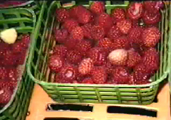Cyclospora

Streaming Video - High resolution | Low resolution | RealPlayer Help
Summary
There are more choices than ever on our grocery shelves - and at the produce counter. Items once considered exotic are now fairly common. All that choice comes with added risk: the risk of getting sick. But scientists are trying to change that.
Transcript of Video
Voice Over
The four corners of the earth meet right in our grocery stores. There are more choices than ever before on our shelves and at the produce counter. High-speed transportation means we can cheat the seasons. Items that were once considered exotic are now fairly common. But all that choice comes with an added cost and an added risk. The risk is that you might get something more than what you paid for, something that might make you sick. But some scientific detectives are trying to make sure that when you buy a berry, all you get is a berry.
Brent Dixon
We're importing more and more produce from developing countries around the world, and we may well get other outbreaks.
Peter Buck
We are disease detectives... given a situation we often walk in without clues.
Brent Dixon
I thinking of Cyclospora as sort of a wake-up call.
Jay Ingram
Exotic produce arrives in Canada from places where the growing season lasts all year-round. But sometimes something else hitches a ride north, along with the fruit and vegetables... Cyclospora is one of those hitch-hikers. It's a single-celled parasite, that reproduces in the human gut. There it forms oocysts... hardy, infective capsules that contain four new parasites. Theses are shed in the feces... From there cyclospora can spread to the hands, or the water supply to continue the cycle of contamination. Since 1996, more than 500 Canadians have fallen victim.
Super
More than 500 Canadian cases in three years.
Brent Dixon
It can often causes a prolonged chronic diarrhea. That's the major symptom. There's many other symptoms as well. Usually abdominal complaints. Things like nausea and vomiting. Also sort of more flu-like symptoms, like fever, and just fatigue, headaches and so on. There's a whole range of symptoms that can show up.
Jay Ingram
When the symptoms showed up again in Toronto last spring, Peter Buck and his fellow "disease detectives" hit the road to investigate.
Super
Peter Buck, Field Epidemiologist, Laboratory Centre for Disease Control
Peter Buck
You ask all the intricate questions about exactly what did you eat? Exactly how was it presented? And that's true whether you're interviewing the chef, that prepared... that formulated the menu, put the menu together, or the sous-chef, who assisted that, or the person who put together things and actually put the food on the plate and put the sauces on the food, or whether you're interviewing the case or the person who attended the event, whether they were a case or not a case. Exactly what did you eat, exactly what did it look like, exactly... you know, did you eat it or didn't you, or were you very likely to have eaten it?
Jay Ingram
And they did find common links. Most of the people affected had attended parties in the Toronto area... Parties where imported Guatemalan raspberries were served. And, their stool samples tested positive for Cyclospora. But there the trail went cold, and with no fresh raspberries from the parties available for testing, lab scientists were unable to prove the fruit was responsible.
Peter Buck
... we were able to epidemiologically link eating fresh raspberries from Guatemala with a risk for illness. What we were unable to do is have the fresh raspberries, and find the Cyclospora organism on the fresh raspberries.
Jay Ingram
What they had was solid evidence... but no "smoking gun." And to this day, that laboratory evidence continues to elude the experts.
Brent Dixon
There's so much still to be done on Cyclospora. This is truly an emerging pathogen. There's a lot that we still don't know about it's basic biology and its life cycles and so on.
Jay Ingram
Scientists don't know how resistant it is to hot or cold temperatures. They don't know how long it can survive in water. They can't grow it in the lab. But they do know it doesn't wash off raspberries easily... And that's a public health risk. So Health Canada researchers are trying to find reliable techniques to detect it on fresh fruit.
Brent Dixon
Nobody has ever found oocysts naturally contaminated on this produce. I think it's just a matter of numbers really. We're capable of detecting Cyclopsora oocysts on produce in the lab when we artificially spike the produce. In nature though, we don't know how many oocysts we're dealing with. We don't know how many oocysts are actually on the produce. In some cases it may be a very small number. And it's really a needle in a haystack kind of a thing.
We have two methods that we're working on right now. We have the Polymerase Chain Reaction, which is a method used to multiply whatever DNA you have many, many times (millions of times), to the point when you actually detect it.
Jay Ingram
It's the same basic process behind "DNA fingerprints" used in police investigations, and it yields a clear black and white "bar code" that confirms Cyclospora is present. In theory it should be sensitive down to one oocyst. In reality, it doesn't work THAT well. And researchers don't know why. The other technique relies on Ultra Violet light. Cyclospora may turn stomachs... but it also turns colour under UV.
Brent Dixon
The second method that we're using is microscopy, and in particular it's called Epiflourescence Microscopy... which takes advantage of the Auto-flourescence of the oocyst. The problem is that it's a very time-consuming tedious process... even for people who are very experienced in identifying cyclospora on a microscope.
What we're trying to do is improve those methods... make them more sensitive and make them a little bit quicker.
Jay Ingram
If they could do that, it would allow food inspectors a chance to conduct random tests... or move more quickly to isolate an outbreak, and remove contaminated produce from stores... thus ensuring fewer people fall ill.
But Dr. Dixon and his colleagues are also working to improve conditions on the Guatemalan farms, where the berries were grown... to stop the spread of the parasite.
Brent Dixon
We're doing what we can to reduce... to minimize that contamination. There are two things that we are looking at in particular, and one is the water quality, in Guatemala, at the source. What we're trying to do is have the farms install microbiological filters and they actually have already started doing that recently. This is the water which is going to be used for washing hands for example, or washing and rinsing equipment, also for use in fumigating the crops. The second thing that we're looking at is improving hygiene of the workers down there.
Jay Ingram
But despite the work, Dr. Dixon says Cyclospora or a similar micro-organism may reappear... and not necessarily from Guatemala. Our growing taste for imported produce from developing countries means any number of stubborn bugs could wind up here. And that makes the battle to find a diagnostic tool all the more urgent.






